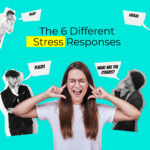
When we're faced with a stressful situation, our body responds to it in one of six ways: flight, fight, freeze, flop, friend, or fawn. While these responses are incredibly common and instinctive, they're often misunderstood—many people confuse flop and fawn or group all three (flop, friend, and fawn) together.
While I go over this in more detail in the FREE Stress & Trauma masterclass, the most simplistic understanding of what stress is the biological process that happens anytime something uncertain happens that requires us to take action. Stress is a normal biological function that allows us to take action and survive.
During the stress response we get a boost of adrenaline so our muscles can move quickly, our eyes open wide to take in our surroundings, our breath quickens and shortens in length, and a number of other physiological changes take place. If we The stress response is often called "Fight or Flight." While the first two responses are indeed flight and fight, there are 4 others.
The easiest way to handle a stressful situation would be to get away from it so this is the first instinct and function of the stress response. While running away is part of this response, most of the stress we experience in modern life is perceived threats (aka anxiety) so there isn't actually any running away. Instead this often looks like someone making lists of things to do, creating a plan of action, thinking about how to respond to a text or email, or what you're going to say to someone the next time you see them.
If you were being attacked by a crocodile, you'd most likely use this response. But when the stress isn't because you're in physical danger and you are beyond the phase of being able to think about a plan, we turn to this response by getting mad and/or blaming others. Maybe you're yelling or bitching about your partner, your kids, your friend, your co-worker, or your boss for doing something that "made you" get mad. This is the fight response in action.
When escaping the stress or fighting the stress isn't an option, we move into the freeze response. We are still have the same excitatory processes going on in our body but instead of taking action, we get stuck. Great response if you're under threat from a gorilla but not so great when you're overwhelmed in your life. Most people will find themselves thinking about the stressful situation over and over again, maybe even talking about it, but they're not actually taking any action to change the stressful situation... they're frozen.
Being in the freeze response takes up a lot of energetic resources in your body, so your brain will begin the process of slowly turning things off and directing your attention away from the stress. This is dissociation. When in the flop response, people will engage in dissociative behaviors such as binge drinking, binge eating, shopping, watching tv, social media scrolling and more.
It's kind of what it sounds like. This response will have you making friends with the stressor (the person or other animal that is causing you stress) in order to reduce the stress you're experiencing. For example, most people are extremely uncomfortable when they see someone else crying and thus creates stress in their bodies. So they will use this response to make friends with the stressor (the person crying) and try to help the stressor stop crying.
Similar to the friend response but slightly different. Making friends with the stressor and trying to figure out how to make the stressor stop stressing takes a lot of energy. But if you have moved into the freeze or flop response, then you will not have enough energy to befriend the stressor. Instead by going along with whatever the stressor wants (aka people-pleasing) you will use less energy and also reduce your stress by appeasing the stressor.
How have these responses shown up in your life? Can you recognize them in other people's behavior?
Once you start noticing them and being aware of them, you'll find that other people stress you at much less than before. And if you're self aware enough, you might even be able to recognize them in yourself as you're doing them and maybe even change your response.